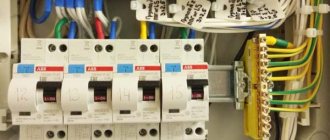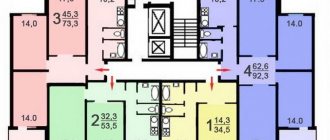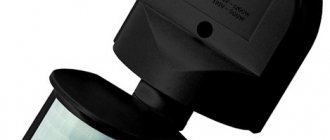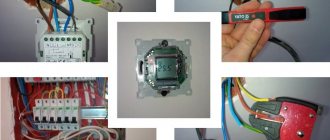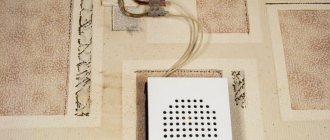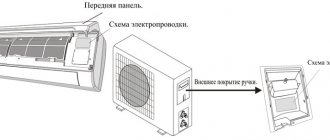If you have installed a lighting fixture in a long hallway and want it to turn off at both ends, you will need a special switch that switches the voltage supply from one pole to the other. The same principle can be used if you are going to power the lighting fixture at the entrance to the room and at the bed or near the desk.
Then you can turn off the general lighting while lying in bed or by turning on the desk lamp on your desk. The stumbling block to the implementation of this scheme is the relatively high cost of such an electrical device, and you will need two of them, so it is much more profitable to make a pass-through switch with your own hands.
Why are pass-through switches needed?
Turning on the lights in a long, dark hallway can be quite inconvenient if there is only one switch located at the end of the room.
The most rational way is to install pass-through switches (another name is cross switches) on different sides of the room. This way you can turn the light on and off immediately after entering the corridor. This is especially true in the entrance of a building, where apartments are located in one line along a long landing, on stairwells, in offices, and industrial premises.
Another option for using this control scheme is a large bedroom with several beds. If you install pass-through switches at each bed, you can turn on the light bulb without getting up. Installation of such devices is justified in dachas, garden plots, and courtyards of private houses. You can turn on the light when leaving the house - after finishing your work, there is no need to walk in the dark.
Main technical characteristics of electrical equipment
Of course, the primary task for the consumer is to select sockets and switches based on their technical characteristics, which will require determining the type of equipment, its dimensions, and operational parameters.
Types of modern sockets and switches
Currently, manufacturers of specialized electrical equipment offer a wide range of products for sale, and the first thing you should pay attention to when choosing the specified accessory is the feature of fastening to the base base.
So, if external electrical wiring is used in a house or apartment, then the choice should be made on surface-mounted sockets and switches. When conductors are recessed in the area of enclosing structures, then built-in accessories should be used.
In addition to the proposed gradation, electrical outlets can also be divided according to functionality.
A standard electrical outlet is used in most premises where additional safety standards are not required. Such objects include living rooms, household premises, etc.
A socket with a grounding contact should be used if it is used to connect electrical devices whose housing may be live. Therefore, powering washing machines, water heating equipment, refrigerators, PCs and similar accessories should only be done using sockets with a grounding contact. (You can read about how to properly install a socket here).
Groups of sockets (from two pieces) assembled into a single module are designed to expand the capabilities of the electrical network and are usually used in places with a large concentration of electrical appliances, namely in kitchens, public places, and residential areas
However, when giving preference to such accessories, you should take into account the capabilities of the existing electrical network (so as not to provoke an overload) and take into account the low mechanical strength of the presented fittings
Electrical sockets with mechanical protection in the form of a curtain or rotary valve are excellent for equipping children's rooms. Indeed, thanks to the design, it will be extremely difficult for a baby to connect to such an outlet or insert a foreign object into it.
Outlets with a high degree of protection against dust and moisture (IP) are ideal for installation in appropriate environments. Shower rooms, bathrooms, boiler rooms, basements and even house facades can be equipped with electrical devices of this type. In most cases, the design of such sockets includes protective spring-loaded covers that reliably protect the contact group from moisture and other debris.
Smart sockets (usually equipped with a timer) are capable of automatically removing the supply voltage. This option has proven itself well in smart homes, as well as in production.
In addition to the listed items, manufacturers of sockets offer a lot of options for special purposes (for switching a telephone, Internet network, television signal, radio, etc.).
If we talk about the types of modern switches, we can distinguish the following types of products:
- Single and multi-key (two, three) differ in the number of switched circuits;
- Equipped with additional lighting (for ease of use at night);
- Pass-through switches with which you can control lighting fixtures from different points. Used in long corridors, on flights of stairs, etc. (We recommend reading about how to install a pass-through switch here);
- Adjustable switches (dimmers) allow you to smoothly regulate the degree of illumination in the room by changing the supplied voltage. Dimmers can be equipped with mechanical (handle) or touch controls, but in any case, their full operation is guaranteed only when using traditional incandescent lamps. That is, it is better not to use such regulators in combination with energy-saving (halogen, fluorescent and LED) lighting devices.
Types of 3 point switch
Switches from three places are represented by two types of products: pass-through and cross. The latter cannot be used without the former. According to the principle of operation, crossovers are divided into:
- Keyboards.
- Rotary. A rotary mechanism is used to close the contacts. They come in a variety of designs and are more expensive than usual.
Taking into account installation, crossbars are divided into:
- Invoices. Installation is carried out on top of the wall; it does not require creating a recess in the wall to install the block. If finishing the room is not planned, then this option is ideal. But such models are not reliable enough, because they are susceptible to external factors;
- Built-in. Installed in the wall, suitable for wiring work in all types of buildings. A hole in the wall is pre-prepared to the size of the switch box.
Passage
Pass-through switch circuit
In a pass-through switch, unlike the classic model, three contacts and a mechanism are built in that combines their operation. The main advantage of the product is the ability to turn it on or off from two, three or more points. The second name for such a switch is “changeover” or “redundant”.
The design of a pass-through switch with two keys resembles two single-key switches independent of each other, but with six contacts. Externally, a walk-through switch cannot be distinguished from a regular switch if not for a special designation on it.
Connection diagram for the pass-through switch wires in the distribution box
Circuit without grounding conductor. Now the most important thing is to correctly assemble the circuit in the junction box. Four 3-core cables should go into it:
- power cable from lighting circuit breaker
- cable to switch No. 1
- cable to switch No. 2
- cable for lamp or chandelier
When connecting wires, it is most convenient to orient them by color. If you use a three-core VVG cable, then it has two most common color markings:
- white (gray) – phase
- blue – zero
- yellow green – earth
or second option:
- White gray)
- brown
- black
To choose a more correct phasing in the second case, follow the tips from the article “Color marking of wires. GOSTs and rules.”
- The assembly begins with neutral conductors. Connect the neutral conductor from the cable of the input machine and the neutral going to the lamp at one point using the terminals of the car.
- Next, you need to connect all the grounding conductors, if you have a grounding conductor. Similar to the neutral wires, you combine the “ground” from the input cable with the “ground” of the outgoing cable for lighting.
This wire is connected to the lamp body. - All that remains is to connect the phase conductors correctly and without errors. The phase from the input cable must be connected to the phase of the outgoing wire to the common terminal of the pass-through switch No. 1.
And connect the common wire from pass-through switch No. 2 with a separate wago clamp to the phase conductor of the lighting cable.
Having completed all these connections, all that remains is to connect the secondary (outgoing) conductors from switch No. 1 and No. 2 to each other. And it doesn’t matter at all how you connect them.
You can even mix up the colors. But it’s better to stick to the colors so as not to get confused in the future. At this point, you can consider the circuit fully assembled, apply voltage and check the lighting.
The basic connection rules in this diagram that you need to remember:
- The phase from the machine must go to the common conductor of the first switch
- The same phase should go from the common conductor of the second switch to the light bulb
- The remaining two auxiliary conductors are connected to each other in the junction box
- Zero and ground are supplied directly to the light bulbs without switches
Method number 1. Two-key switch
This method allows you to obtain pass-through switches from conventional two-key models. This is especially convenient if you don't want to spend time making complex changes to their design or don't have the appropriate tools.
Rice. 2. Two-key model of pass-through switch
To implement this model of a pass-through switch, you will need two two-key devices, connecting wires and a lighting source.
Once you have collected everything you need, follow these steps:
- Turn off the voltage on the panel using a circuit breaker - this will prevent electric shock during installation work. It will be more reliable if you simultaneously disconnect both the neutral and phase conductors for the corresponding lamp.
- Connect the first of the two-gang switches to the phase wire of the three-core cable. To do this, release the terminal on the switch and insert the core there. The core is clamped until reliable contact is obtained with minimal resistance to electric current.
- Also connect a wire to each of the output contacts. Next, lead them to the output contacts of the second two-key switch.
- From the input terminal of the second switch, take the wire to the lighting device.
If the lighting system is carried out as part of a major overhaul and replacement of all lamps and appliances in the house, then the walls are tapped for power distribution. Otherwise, you can get by with external installation in the cable channel. In case of a long distance between switching points, it is better to carry out wiring with a three-core cable. Since three wires are optimally used for intermediate connection of wires.
It should be noted that the above method works by simultaneously switching two keys at once, so each time you need to operate two buttons at once, moving them to opposite positions.
Otherwise, the logic of the circuit will be broken and next time you simply will not be able to turn off the light bulb. Therefore, if other household members may be negligent about such switches, it is better to redesign the device to a single-key version.
Design and features of pass-through switches
The external pass-through device does not differ from the standard one. The difference can only be noticed when examining the product from below - manufacturers apply triangles on the body, directed horizontally downwards. The second difference is 3 terminals with copper contacts. One is located on top, and two are located below. Also, the pass-through device is switched through a three-core VVG-ng or NYM cable with a cross-section of 1.5 mm².
Depending on the number of buttons, there are two-key, one-key and three-key modifications.
The difference between a pass-through and a regular switch.
In comparison with classic two-pole models, you need to connect the adapter according to the following principle:
- serial connection of switches;
- the phase does not open, but switches to the second line;
- There are more output contacts than input contacts.
The paired poles of the switches are located opposite each other.
Nuances of choice
Before purchasing a pass-through switch, you need to consider:
- Mounting method depends on the type of wiring. Overlays are installed on the surface using self-tapping dowels. Built-in - in socket boxes on spacer legs.
- Degree of protection - models with IP03 are suitable for a bedroom or corridor, for a bathroom - with IP04-IP05, for the street - with IP55.
- Type of contact terminals. Screws with pressure plates are reliable. Screwless spring ones are easier to install.
- Terminal markings - N (zero), L (phase) and ground (ground) are used. The letters I and O indicate the position of the buttons when turned on and off.
According to the type of control, the adapters can be keyboard, touch, or with remote control.
Connecting a pass-through switch
First of all, you need to correctly connect the switch itself in the socket box. Remove the key and the overhead frames.
When disassembled, you can easily see the three contact terminals.
The most important thing is to find the common one. On high-quality products, a diagram should be drawn on the reverse side. If you understand them, you can easily navigate through it.
If you have a budget model, or any electrical circuits are a bit of a mystery to you, then an ordinary Chinese tester in circuit continuity mode, or an indicator screwdriver with a battery, will come to the rescue.
Using the tester's probes, alternately touch all the contacts and look for the one on which the tester will “squeak” or show “0” at any position of the ON or OFF key. It's even easier to do this with an indicator screwdriver.
After you have found the common terminal, you need to connect the phase from the power cable to it. Connect the remaining two wires to the remaining terminals.
Moreover, which one goes where does not make a significant difference. The switch is assembled and secured in the socket box.
Do the same operation with the second switch:
- look for the common terminal
- connect the phase conductor to it, which will go to the light bulb
- connect two other wires to the remaining ones
Criteria for choosing wisely
When purchasing a triple switch, carefully inspect it, study the physical quantities, and check for the presence of a connection diagram.
Key points to consider when choosing a product:
- The body of the product must be free of any kind of defects: burrs, dents and chips.
- The keys should operate easily and without jamming.
- Sound effects – when each key is turned on, a characteristic click should be heard.
- The core must also be free of burrs, and its terminals must work properly.
When planning to install a switch in a room with high humidity, you must choose a device with protection.
The working elements of a waterproof switch have an additional rubber or plastic shell, which protects the mechanism from direct contact with water
To simplify the installation procedure and ensure the longevity of the device, preference should be given to models whose cores are equipped with screw or clamp type terminals.
During the installation of imported triple switches, especially Korean and Chinese products, difficulties may arise that are worth thinking about in advance:
Changeover switches - lighting control circuit from 3 places
But what if you want to control one lighting from three or more points. That is, there will be 3, 4, etc. switches in the circuit. It would seem that you need to take another pass-through switch and that’s it.
However, a switch with three terminals will no longer work here. Since there will be four connected wires in the junction box.
Here a changeover switch, or as it is also called a cross, cross, or intermediate switch, will come to your aid. Its key difference is that it has four exits - two from below and two from above.
And it is installed precisely in the gap between two passageways. Find in the junction box two secondary (not main) wires from the first and second pass-through switch.
Main types of closing devices
Switches, including triple switches, depending on the control method, come in keyboard and touch versions. The first are set in motion by pressing a key, the second - by touching the panel in a certain place.
Most models of touch switches are equipped with a dimmer - a device for smooth six- or seven-step adjustment until the light turns off
When choosing a dimmer, it is important to focus on the total load of the switch. Experts recommend purchasing devices with power reserves. For example: for a three-arm chandelier with lamps with a power of up to 100 Watt, choose a dimmer labeled 300 W
For example: for a three-arm chandelier with lamps with a power of up to 100 Watt, choose a dimmer labeled 300 W.
Read more about what a dimmer is and how to choose one in this material.
Depending on the type of installation, triple switches are of three types:
- for external installation;
- internal, involving penetration into the wall cavity;
- combined models that have a common housing with a socket.
Combined models equipped with a socket have a narrower scope of application. This is due to the fact that their installation is impossible without altering the electrical wiring.
When installing a combined device, you have to connect two separate wires for the socket to the same point and at the same time remove phase wires from them for lighting
Installing a triple switch combined with a socket in a common housing is justified in situations where it is intended to install open wiring. Electrical safety rules strictly regulate the height of placement of switches and sockets - 150 cm from the floor.
For this reason, such models are installed in places where sockets are used quite often, provided that switches at this height are convenient to use.
Combined models are most widespread when arranging bathrooms with placement near mirrors and bedrooms in the area of bedside tables.
A separate subspecies includes triple wireless switches, which can be installed anywhere and placed on any surface.
The wireless model is a different type of switch, which is more similar in design to a remote control
Wireless devices are equipped with two modules:
- The receiver is a relay-type device built into the light source. When it receives a signal, it closes the lighting circuit.
- The signal transmitter is the switch itself, equipped with an energy generator. When you press a key, it processes the energy pulse into a radio signal.
Such high-tech devices are expensive. Instead of the usual electrical wiring, they use infrared or radio waves.
Switches equipped with backlight are also available for sale. They are convenient in the sense that in the dark they create a light signal, which serves as a good guide for quickly finding the device.
The backlight on the switches additionally acts as an indicator, which signals the non-working state of the lighting, since it turns on when voltage is not supplied to the device
When choosing such models, you should pay attention to the type of lighting source. Illuminated switches do not cause trouble only when connected in a circuit with conventional incandescent lamps or their halogen counterparts. If fluorescent lamps or LED strips are used in a circuit with such a device, then even when turned off they will continue to emit a slight pulsating glow
If fluorescent lamps or LED strips are used in a circuit with such a device, then even when turned off they will continue to emit a light pulsating glow.
Application of the scheme
In long corridors, pass-through switches are often used. Pass-through models are designed for the convenience of supplying or removing voltage from lighting fixtures from different ends of the room. Most often this scheme is used:
- In a long corridor with exits from different rooms. One switch is placed at the exit, a second one in the middle, and a third one at the end.
- In the courtyards of country and private houses, dachas. Switching devices are installed at the exit from the house and outbuildings.
- In three-story apartment buildings. A device is placed on the ground floor to turn it on. You can turn off the lighting on the second and third floors.
- In a children's room with several beds. The solution provides for one device at the entrance and two next to the sleeping areas.
- Flights of stairs and landings of cottages outside the city. One device is mounted at the beginning of the stairs, switching off is carried out from the second floor or near the attic.
By using a pass-through switch, energy savings are ensured.
How to connect a socket-switch unit in one housing: diagram and sequence of actions
A socket, switch and lamp are the main components of any electrical wiring in an apartment, private house, garage or other office space. Therefore, every prudent homeowner must know how to connect the circuit of all devices when carrying out repair work or constructing a new structure with their own hands, including combined ones, which are combined in one building.
Not so long ago, connecting the wires from the switch to the AC electrical circuit was done at random.
Therefore, in old houses, most of these electrical circuit devices still remain connected in violation of all safety rules.
Naturally, this did not affect the operation of the switch itself, but the safety of operation of such a device remains in great doubt.
Recently, to save wires and space on the wall, manufacturers of electrical appliances have begun to combine and combine several devices in one housing. In this case, most often they combine a socket and a key switch in such a way that, thanks to this connection scheme, maximum efficiency and ease of use of such electrical devices is achieved.
Disadvantages of pass-through switches
One of the disadvantages of walk-through switches is the need to drill walls under them. Organizing a power line with a pass-through switch has several disadvantages:
- time and effort spent on wall slitting for hidden wiring;
- the need to connect the remote control via a regular key for models with motion sensors;
- unprofitability for an apartment due to cable grooves and installation of a DIN rail;
- difficulties with identifying terminals;
- lack of clarity of the “ON” and “OFF” positions.
Experts note that the devices are more suitable for country cottages, dachas, and the private sector than for an apartment.
A pass-through switch is convenient to use in rooms with several groups of lighting fixtures. The device provides comfortable light control and safe movement of people. Currently, the pass-through light switch circuit, controlled from three places, is not tied to the layout of a residential property.
Instructions for replacing the light switch
Before replacing a new light switch in an apartment, you need to dismantle the old keypad and make sure the wiring is in good condition.
How to remove the old switch?
Dismantling the old switch is carried out in accordance with the step-by-step instructions:
- Remove the key and top cover.
- Disconnect the wires using a screwdriver, unscrewing the bolts on the terminals.
- Apply power to the distribution panel and locate the phase wire using the indicator.
- Turn off the mains voltage.
- Mark the phase with insulating tape or another method.
- Loosen the screws holding the spacer tabs.
- Remove the device from the socket.
Scheme for dismantling the old switch
In some cases, the sequence will be reversed - the wires can be disconnected only after the switch is removed. This depends on the design features of the device.
Dismantling the external switch is carried out in a similar manner. The only difference is that instead of loosening the screws of the spacer legs, the screws that secure the device to the wall are unscrewed.
Video instructions for dismantling the old switch can be viewed on the channel “Guys from Stone. Do-it-yourself apartment renovation.”
We are preparing for connection
Before connecting a new device, you must complete the following preparations:
- Loosen the screw terminals so that the wires fit easily into the hole.
- Unscrew the screws of the spacer tabs so that the switch fits freely into the socket box (this operation is not required for outdoor devices).
- Strip the wires when replacing them (if the condition of the old electrical cable is good, there is no need to strip it).
Diagram and connection with one button
After everything is prepared, you can install a breaker with one key, following the detailed algorithm:
- Examine the markings on the terminals of the single-key switch. The phase wire must be connected to contact L, the second end of the cable to connector 1, respectively.
- Insert the bare wires into the contact holes and tighten the terminal screws. Do not apply too much force, otherwise you may break the thread.
- Install the switch in the socket box strictly horizontally without distortion.
- Secure the device with the sliding tabs by tightening the screws.
- Check the correct operation of the lighting fixtures by turning on the circuit breaker on the electrical panel.
- If the switch operates correctly, install the cover and keys.
Diagram and connection with two buttons
Algorithm for installing a switch with two keys:
- Connect the phase wire to contact L, the remaining two ends to connectors 1 and 2 in accordance with the markings.
- Tighten the fastening screws (this operation is not necessary on spring terminals).
- Place the switch in the socket box.
- Tighten the screws of the sliding legs, eliminating even minimal gaps.
- Make sure that the device works correctly by turning on power.
- Install the cover and both keys.
Step-by-step instructions for installing a two-key switch are given in the photo gallery:
Non-standard situation
There are often cases when the wire inside the socket box is too short. It is not long enough to connect a new switch. Such unusual situations arise in old houses, where electrical appliances have already been replaced several times, and the wiring has become unusable. In this case, the cable must be extended.
This will require additional tools and consumables, namely:
- hammer;
- chisel;
- putty knife;
- two-core wire 10–15 cm long;
- a little putty or plaster;
- insulating tape.
Only wires of the same types can be spliced together. A copper cable cannot be connected to an aluminum one - this can lead to oxidation in the contact area, decreased conductivity and burnout of the wiring.
Cable extension is performed in the following sequence:
- Determine in which direction the cable is laid in the wall.
- Carefully release a piece of wire about 10 cm long using a hammer and chisel.
- Cut off the damaged cable section with pliers.
- Strip the ends of the new and old cable, completely removing the insulation in a section of at least 2 cm.
- Tightly twist the protected wires together.
- Wrap the exposed areas tightly with insulating tape.
- Place the connected cable into the channel.
- Cover the damaged area with plaster or putty.
After the solution has completely hardened (after 15–20 minutes), you can continue to install the new switch.
Connection errors
Many people make a mistake at the stage of searching and connecting the common terminal in the pass-through switch. Without checking the circuit, they naively believe that the common terminal is the one with only one contact.
They assemble a circuit in this way, and then for some reason the switches do not work correctly (they depend on each other).
Remember that on different switches the common contact can be anywhere!
And it is best to call it, what is called “live”, with a tester or an indicator screwdriver.
Most often, this problem is encountered when installing or replacing pass-through switches from different companies. If everything worked before, but after replacing one circuit the circuit stopped working, it means the wires were mixed up. But there may also be an option that the new switch is not pass-through at all. Also remember that the lighting inside the product cannot in any way affect the switching principle itself.
Another common mistake is incorrectly connecting crossovers. When both wires are placed from pass-through No. 1 to the upper contacts, and from No. 2 to the lower ones. Meanwhile, the cross switch has a completely different circuit and switching mechanism. And you need to connect the wires crosswise.
Selecting a three-key switch
When choosing a three-circuit switch, you should carefully examine it. You should study the physical characteristics and make sure that the wiring diagram is present. A high-quality three-key player has the following characteristics:
- There are no scratches, dents or damage on the case.
- The keys work easily and do not stick.
- Turning on 1 key is accompanied by a click.
- The core and its clamps function properly.
For rooms with high humidity levels, you need to purchase a device that has special protection. Cores with screw and clamp terminals have additional advantages. This will make installation easier and extend the life of the switch.
It is not recommended to buy a device with any defects. Not only uninterrupted lighting, but also safety directly depends on this.
Using three-switch circuits
The switching mechanism in pass-through switches is located in the center of the contacts. The device provides comfortable light control and safe movement of people. With such a power supply arrangement, identical devices will not work. The more devices are involved in the implementation of the control system, the more complex the construction scheme becomes.
Useful video Switch from three places - a modern solution for light control Electricity and other resources are rising in price, and the emergence of modern technologies allows for significant savings. Many novice, non-professional electricians confuse these concepts and try to organize a pass-through circuit on a three-key switch. Take a screwdriver with a phase detector or a multimeter, and look for where the plus is and where the minus is. We are talking about long corridors, stairs, basements.
Let's say one of them will be located near the bed, the second at the exit of the room, and the third near the desktop. The appearance of the duplicating devices is almost the same as that of a single-key device. Three-key pass-through switch Such a switch is not actually a pass-through switch, and cannot be used in a lighting circuit with several switching points. If you need a diagram for connecting a pass-through switch from two places, see it in this article.
During installation, the switches are installed so that when turned off the keys are in the same direction. It contains both an input and an output in the amount of 2. Meanwhile, the cross switch has a completely different circuit and switching mechanism. According to the wiring rules, all wires in such an electrical circuit must be located at a distance of 15 cm from the ceiling. The lighting device is turned on when 2 switches are in the same position.
Similar fastening of the remaining outputs. And the other two are installed on some courtyard buildings: a garage, a shed, upon reaching which you can turn off the lighting. In everyday life, not only step-down transformers are used, but also step-up transformers. The apartment buildings have three floors.
Conclusions and useful video on the topic
It is best to imagine how to properly connect wires and install devices by watching a training video.
Two-keyboard for two lamps:
Nuances of connecting a chandelier:
Useful connection tips:
The procedure for installing and connecting a double switch can be performed without the involvement of a qualified technician, but during work you should remember the safety rules. Before electrical installation work, it is necessary to take into account all factors and choose the right circuit.
Do you have anything to add or have questions about connecting a double switch? You can leave comments on the publication and participate in discussions. The contact form is located in the lower block.
How to convert a single switch to a double one
Post by Vadim » Jan 11, 2015, 11:01 am
How to convert a single switch to a double one
Sponsor
Re: How to convert a single switch to a double one
Post by anatmar » Jan 11, 2015, 01:02 pm
Re: How to convert a single switch to a double one
Post by Igor » 12 Jan 2015, 08:34
If you forgot about the third wire in the wall, "just a double switch" won't help. You'll have to solder or buy some kind of relay. For example, like this:
Re: How to convert a single switch to a double one
Post by andter435 » Jan 13, 2015, 9:10 pm
Re: How to convert a single switch to a double one
Post by Igor » Jan 14, 2015, 09:14
This solution can be very expensive, especially if the apartment has just been renovated. I have provided a diagram of a simple relay that solves the problem. Here's another circuit, this time without a transformer:
Example of lighting operation
- When you turn on key No. 1, the lamp lights up, electricity flows through the phase wire and is indicated by the letter L, and the flow of current is shown by the red line.
- Press the key back and the light goes out.
- We switch the adapter disconnector, the lamp lights up.
- Press the key again and the lamp turns off.
- When device No. 3 is turned on, the lamp lights up.
- Pressing again turns off the lamp.
Recommendation: if it is necessary to increase the number of control points for the luminaire, add the desired number of cross switches between the staircase switches.
Cabling
On the eve of connection, it is necessary to study the corresponding diagram. This will prevent many annoying mistakes.
The box contains several wires, each of which is responsible for a strictly defined task:
- The three-core cable goes to the machine installed in the panel niche;
- The four-wire cable is routed to the three-button.
Necessary equipment and materials
- Switches
- Mounting box
- Electrical insulating tape
- Terminals
- Phillips and regular screwdrivers
- Installation knife
- Side cutters
- Pliers
- Wrenches
- Electric cable
If the room has already been wired and you need to install redundant switches, then you need to make grooves or open installation of cables. In order to make grooves you will need a hammer drill and a wall chaser. You also need alabaster. He will secure the corrugated pipe. In case of open installation, a distribution box is required; it is attached to the wall using a corrugated pipe.
Decorative and functional facial details
The housing structure also contains fastening elements and a number of front parts. This is a plastic frame and three key inserts.
- The frame is necessary to cover the edges of the wall recess into which the switch is mounted.
- It also effectively protects the wallpaper from sweat and dirt, which are present to one degree or another on the hands.
- The wider the installed frame, the cleaner the wall around the switch will be after 1-2 years of operation.
- These parts are detached without much effort, after which they are just as quickly fixed on the spacer fasteners.
Original industrial design
A three-circuit light switch is better than analogues with fewer keys for a number of reasons. Firstly, such a device looks much more original, which is pleasing to the eye and brings zest to the interior, which is sorely lacking in the era of widespread minimalism and pragmatism.
You can be convinced of the unusual design of this device and its aesthetic superiority by studying a couple of dozen photos of three-key switches.
Step-by-step installation instructions
- Disconnect power to the room.
- Determine where the wires are so as not to damage them.
- Designate the future location of the junction box.
- Install the mounting box.
- Laying electrical cables. It is better to take a 3 or 4 core cable. For changeover devices, a three-wire cable is required. Using one core, a phase supply or a lamp will be connected. Two cores are connected to intermediate wires. For a crossover device, you need a four-core cable - two wires for each switch. Two will lead to the first, and the remaining two will lead to the second.
The ends of all cables are led into the installation box and connected with terminals. And the zero goes to the lamp. To equip a pass-through switch with control from 3 places, you must have skills and an accurate connection diagram. Its presence makes it possible to install a correct and high-quality lighting system. And on its basis you can easily create more complex illumination schemes.
Comments:
Igor
Whatever one may say, three keys in one regular place is too much. Inconvenient to use, inconvenient to connect. One big inconvenience
Kolyan
Igor, I agree. Such a switch can only be used as a temporary measure, and even then I can’t imagine cases where it might be needed. Chandelier with 7 lights? Or when?
Oleg
Someone uses them, since they are sold. And the article is good. Everything is explained clearly and in detail what is connected and why and how to use it. And chandeliers with 7 lamps are really a thing of the past...
Uri
Is it possible to connect a switch with a socket in the same housing so that when you press one of the keys, the electricity supply to the socket is turned off?
Kolyan
Uri, no, if everything is done in one case, then everything is already wired there. Needs to be soldered.
Igor
Uri, it is not advisable to do this, especially if you are going to connect a powerful consumer to the outlet. for example a water heater. The switch is not designed for such a load and will soon fail
Mikhalych
Where to use? My hallway turns into an L-shaped corridor and there are two lamps (in the hallway and corridor). Everything is turned on with one switch, and the third switch connects the diode to the lamp in the corridor. All lamps are LED (homemade), so turning them on via a diode makes a wonderful night light in a crooked corridor at night.
Leave a comment Cancel reply
An outdoor waterproof socket is an important attribute of your site
How to connect a Lezard pass-through switch and what circuit to use.
Retro sockets - design element or functional detail?
DIY triple socket installation. How to carry out the work.
Switching conductors in a junction box
There are five wires in the box that should be neatly combined into clusters of wires.
- All zeros must converge at one point.
- Next, you need to connect the phase conductors, and then connect the conductors extending from the keys to the phases.
- When installing in this case, it makes sense to simplify your task by using Vago clamps.
- On the eve of the first switching on, you need to make sure that the three-key switch connection diagram is correct.
- Then the machine starts and the lights turn on.
Advantages
From installing such a triple switch you will receive the following advantages:
- Externally, one switch with three keys looks more compact and more aesthetically pleasing than three single ones.
- Laying electrical wires to the connection point will be less expensive in terms of labor and money.
- You will need to make one technological niche in the wall for the mounting box instead of three.
- Economic effect. For example, if your chandelier has 3-4 light bulbs, then turning on a single-key switch ensures that all of them work at once, while consuming maximum electricity. But such illumination is not always necessary; dim light is sufficient. If you install a 3-key household switch for such a chandelier, then, if necessary, one or two lamps are turned on, thereby saving almost half of the electricity.
